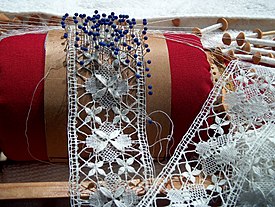Lace: Difference between revisions
m →Types: Delete spurious punctuation |
cite source |
||
| Line 4: | Line 4: | ||
[[File:Bobbin lace 5054 Nyplätty pitsi C.JPG|thumb|275px|right|An example of [[bobbin lace]] during manufacture.]] |
[[File:Bobbin lace 5054 Nyplätty pitsi C.JPG|thumb|275px|right|An example of [[bobbin lace]] during manufacture.]] |
||
'''Lace''' is an openwork [[fabric]], patterned with open holes in the work, made by machine or by hand. The holes can be formed via removal of threads or cloth from a previously woven fabric, but more often open spaces are created as part of the lace fabric. '''Lace-making''' is an ancient craft. True lace was not made until the late 15th and early 16th centuries. A true lace is created when a thread is looped, twisted or braided to other threads independently from a backing fabric. |
'''Lace''' is an openwork [[fabric]], patterned with open holes in the work, made by machine or by hand.<ref>{{cite web| url= http://www.thefreedictionary.com/lace |title=Show election|publisher=Lace|accessdate=2012-23-05}}</ref> The holes can be formed via removal of threads or cloth from a previously woven fabric, but more often open spaces are created as part of the lace fabric. '''Lace-making''' is an ancient craft. True lace was not made until the late 15th and early 16th centuries. A true lace is created when a thread is looped, twisted or braided to other threads independently from a backing fabric. |
||
Originally [[linen]], [[silk]], gold, or silver threads were used. Now lace is often made with [[cotton]] thread, although linen and silk threads are still available. Manufactured lace may be made of [[synthetic fiber]]. A few modern artists make lace with a fine copper or silver wire instead of thread. |
Originally [[linen]], [[silk]], gold, or silver threads were used. Now lace is often made with [[cotton]] thread, although linen and silk threads are still available. Manufactured lace may be made of [[synthetic fiber]]. A few modern artists make lace with a fine copper or silver wire instead of thread. |
||
Revision as of 21:55, 23 May 2012

Lace is an openwork fabric, patterned with open holes in the work, made by machine or by hand.[1] The holes can be formed via removal of threads or cloth from a previously woven fabric, but more often open spaces are created as part of the lace fabric. Lace-making is an ancient craft. True lace was not made until the late 15th and early 16th centuries. A true lace is created when a thread is looped, twisted or braided to other threads independently from a backing fabric.
Originally linen, silk, gold, or silver threads were used. Now lace is often made with cotton thread, although linen and silk threads are still available. Manufactured lace may be made of synthetic fiber. A few modern artists make lace with a fine copper or silver wire instead of thread.
Types

There are many types of lace, classified by how they are made. These include:
- Needle lace; such as Kenmare Lace are made using a needle and thread. This is the most flexible of the lace-making arts. While some types can be made more quickly than the finest of bobbin laces, others are very time-consuming. Some purists regard needle lace as the height of lace-making. The finest antique needle laces were made from a very fine thread that is not manufactured today.
- Cutwork, or whitework; lace constructed by removing threads from a woven background, and the remaining threads wrapped or filled with embroidery.
- Bobbin Lace; as the name suggests, made with bobbins and a pillow. The bobbins, turned from wood, bone or plastic, hold threads which are woven together and held in place with pins stuck in the pattern on the pillow. The pillow contains straw, preferably oat straw or other materials such as sawdust, insulation styrofoam or ethafoam. Also known as Bone-lace. Chantilly lace is a type of bobbin lace.
- Tape lace; makes the tape in the lace as it is worked, or uses a machine- or hand-made textile strip formed into a design, then joined and embellished with needle or bobbin lace.
- Knotted lace; including macramé and tatting. Tatted lace is made with a shuttle or a tatting needle.
- Crocheted lace; including Irish crochet, pineapple crochet, and filet crochet.
- Knitted lace; including Shetland lace, such as the "wedding ring shawl", a lace shawl so fine that it can be pulled through a wedding ring.
- Machine-made; any style of lace created or replicated using mechanical means.
- Guipure; The stitching area is stitched with embroidery threads that form a continuous motif. Afterwards, the stitching areas are removed and only the embroidery remains. The stitching ground is made of water-soluble or non heat-resistant material.
History

Objects resembling lace bobbins have been found in Roman remains, but there are no records of Roman lace-making. The craft may have begun in the first half of the 14th century in Flanders (now on the border between France and Belgium).
Lace was used by clergy of the early Catholic Church as part of vestments in religious ceremonies, but did not come into widespread use until the 16th century.[2] The popularity of lace increased rapidly and the cottage industry of lace making spread throughout Europe to most European countries. Countries like Finland (town of Rauma), Czech Republic (town of Vamberk), Slovenia (town of Idrija), England (town of Honiton), France, Belgium, Hungary, Ireland, Malta, Russia, Spain, Turkey and others all have their own unique artistic heritage expressed through lace.
In North America in the 19th century, lace making was spread to the Native American tribes through missionaries.[3]
St. John Francis Regis helped many country girls stay away from the cities by establishing them in the lacemaking and embroidery trade, which is why he became the Patron Saint of lace-making.[citation needed]
Traditionally, lace was used to make tablecloths and doilies and in both men's and women's clothing. The English diarist Samuel Pepys often wrote about the lace used for his, his wife's, and his acquaintances' clothing, and on May 7, 1669 noted that he intended to remove the gold lace from the sleeves of his coat "as it is fit [he] should", possibly in order to avoid charges of ostentatious living.[4]
Military uniforms
The term 'lace' is used by the British to refer to the gold bands sewn onto the sleeves of naval officers' uniforms to indicate rank, and to name the similar decoration elsewhere on other uniforms (such as Italian caps and Polish collars) because of the procedure used to make it. In America, the term is not used for this purpose because the bands are metal compactly sewn, while 'lace' seems to imply cloth sewn into patterns with holes in them.
See also
- Antwerp lace
- Binche lace
- Brussels lace
- Bucks point lace
- Chantilly lace
- German lace
- Point de Gaze
- Torchon lace
- Valenciennes lace
- Vamberk lace
References
- ^ "Show election". Lace. Retrieved 2012-23-05.
{{cite web}}: Check date values in:|accessdate=(help) - ^ Lacemakerslace.oddquine.co.uk
- ^ Lace.lacefairy.com
- ^ Diary of Samuel Pepys, May 7, 1669.
External links
- Online Lace Demonstrations
- Virtual Museum of Textile Arts (in Italian)
- A lace collection including images and descriptions


